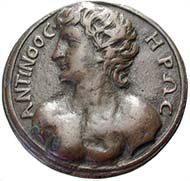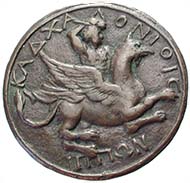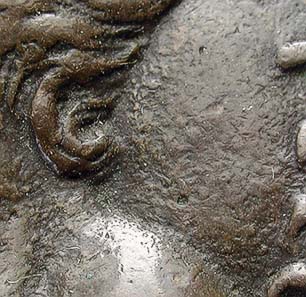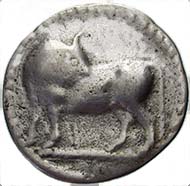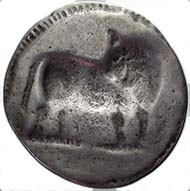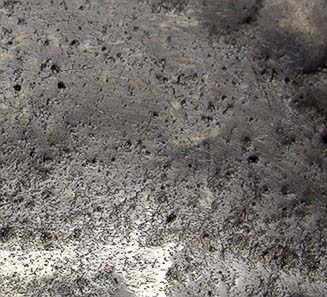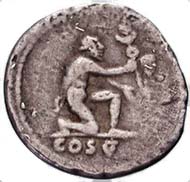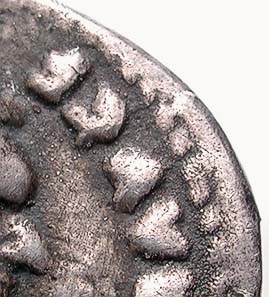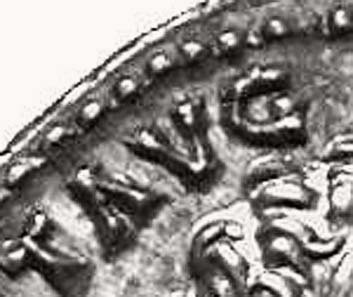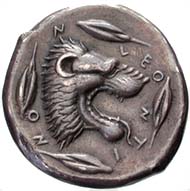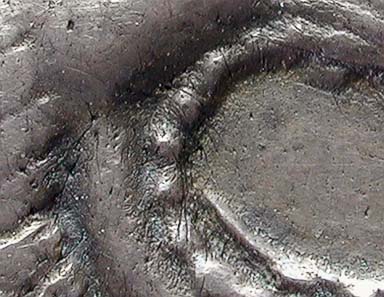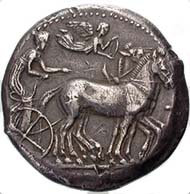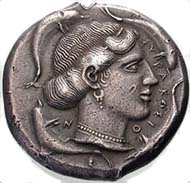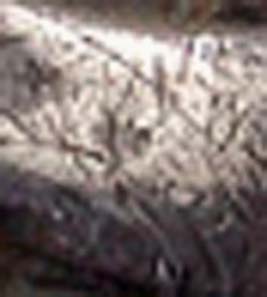by courtesy of the IBSCC
Part 2: Cast counterfeits
After having shown how to detect counterfeits from newly cut dies we will deal with those fakes that have been cast. Once again, we see here an old imitation of a Roman coin that was made during the Renaissance period. It is a free imitation of a bronze coin of Antinoos (fig. 1).
Fig. 1: Cast Renaissance medal showing the bust of Antinoos.
But neither the way the image was created, nor the way the medal was produced has anything to do with ancient production methods. With a magnifier one will immediately see the small cast holes on the unfinished obverse (fig. 2).
Fig. 2: Enlargement of the obverse of fig. 1.
In part 1 we showed how to detect fakes with the help of small variations in style. Cast fakes never differ in style from the original, therefore this criterion doesn’t help. Casts imitate exactly the original coin that has been the form for its mould. We have to detect the casts by looking at the surface appearance of the coin.
There are bad casts that can be recognized at first sight. And there are very well executed casts that can’t be discovered without using a microscope. Most casts are something in between. But if you learn with easy cases how to find the cast holes, you will also be able to identify the better casts: See here a bunch of casts in a row from very simple to difficult:
Fig. 3: Forgery of a stater from Sybaris.
Fig. 3 is the coin to start with: a very bad cast of a stater from Sybaris. You will see immediately without using a magnifier that this coin can’t be genuine. Big cast holes can be seen all over the coin (fig. 4). This was the simple case for the beginner.
Fig. 4: Enlargement of the obverse of fig. 3.
Fig. 5 is already a little bit more difficult. Here we have something that was meant to be a denarius of Domitian. Similar pieces are found in big auction lots that were made from coins coming from old collections. Nobody would ever bother to look carefully at this coin. It is simply not worth it. And that is the chance of bad casts like this. You won’t see the cast holes with the naked eye. You will need a magnifier. But with the help of a magnifier you will see the small circular cast holes on the relief immediately. The cast holes spread all over the field have been covered with dirt.
Fig. 5: Forgery of a denarius of Domitian.
If you look carefully with a magnifier at this piece you will find a second criterion for a cast fake. The letters are weak and not sharp at all (fig. 6).
Fig. 6: Enlargement of the obverse of fig. 5.
The striking process produces a luster and sharp contours (fig. 7). Even coins that have been touched by many hands normally show a trace of this sharpness, sometimes even a trace of the luster. But no trace of sharpness can be seen at the contours of this denarius.
Fig. 7: Enlargement of an authentic denarius of Domitian. From Leu Numismatic AG, Zurich 86 (2003), 820.
Fig. 8 shows a fake of a tetradrachm of Leontinoi. This coin could become very dangerous for somebody who doesn’t use a magnifier, because it has been covered by an artificial patina, to give the impression that this coin comes from an old collection. On first sight a desirable piece. And this coin was sold once by a very prominent coin auction house. But with a second careful look you will realize that the patina is fake and that there are cast holes on the grain to the left of the lion’s head and around the mouth of the lion (fig. 9 and 10).
Fig. 8: Forgery of a Leontinian tetradrachm.
Fig. 9: Enlargement of the reverse of fig. 8 (jaws of the lion).
Fig. 10: Enlargement of the reverse of fig. 8 (grain behind lion head).
This fake of a tetradrachm from Syracuse is even more dangerous (fig. 11). Without a magnifier you will see slight damages typical for coins coming from old collections. With the naked eye you recognize scratches and punches. But when you look carefully at the coin with a magnifier you will see that all these scratches and punches help to distract the attention of the beholder from the tiny circular cast holes which you will easily discover on the flank of the horse drawing the chariot (fig. 12).
Fig. 11: Forgery of a Syracusan tetradrachm.
Fig. 12: Enlargement of the obverse of fig. 11 (body of the horse).
And this is exactly what makes most of the cast fakes so dangerous: Most of the coins we hold in hand have been cleaned. Sometimes the surface structure has been strongly damaged by the cleaning process. After this damage it is sometimes very difficult, if not impossible, to decide whether a coin was cast or not. It is a good idea for a collector to be very careful with cleaned coins.
Let’s close with a last criterion that reveals a cast forgery. If you take a coin in your hand and look at it from the side and you realize that the surface is not concave, as it ought to be because of the pressure that has been applied using a hammer to strike it, if the surface is convex which is technically not possible if you have a struck coin, then you will have to conclude that the coin is cast and fake.
Fig. 13: Forgery of a Siculopunic tetradrachm.
Fig. 13 is the last example of a cast coin – a very well executed imitation of a Punic tetradrachm from Sicily. The obverse was done perfectly, but if you turn the coin around you will discover all characteristics of a cast I have presented to you: the missing luster even for a coin in nice condition, the cast holes and the slightly convex surface. And this is another rule, if one side of a coin is fake, the other side can’t be genuine.
The next article will be dedicated to a third group of fakes: electrotypes.
| IBSCC is the abbreviation for the International Bureau for the Suppression of Counterfeit Coins. It was founded in 1975 by the the International Association of Professional Numismatists (IAPN), a non profit organization of the world’s leading professional numismatic firms with 112 members from 23 countries. IAPN members unconditionally guarantee the authenticity of the coins they sell. |



